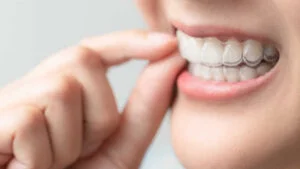
You’ve probably seen the ads on TV, Instagram, and Facebook for companies offering mail-order aligners and claiming to achieve the same results as orthodontics at much lower fees. There are many questions that come to mind when evaluating a company like this. Will there be fees for visits with a general dentist to obtain X-rays and monitor care? Will you need any dental care prior to starting treatment? Will you ever be seen by a professional in person during treatment? Will your bite get worse during treatment? How will you ensure treatment is progressing well? Here are some more factors to consider!
CHOOSING EXPERT PROVIDERS
Who provides your care? When you go to an orthodontist, you can trust their expertise. An orthodontist must complete all the schooling required to become a dentist PLUS two to three years of additional training focused on tooth movement and jaw alignment. Only about 6% of dentists are orthodontists. This process takes over 5,000 hours of specialty training. Experts, like Dr. Hutta and Dr. Price, don’t stop there. With continuing education and a commitment to providing the best services and technologies, specialists deliver top-notch, personalized care that you can rely on.
Direct-to-consumer companies typically have fewer orthodontists on staff and more general dentists. General dentists have less experience and training when it comes to delivering orthodontic care. Some companies are not transparent about which doctor is overseeing your care. Make sure you know who your doctor is and research their background, credentials, and check patient reviews before beginning treatment.
TREATMENT OPTIONS
Everyone has different treatment needs, and it takes a thorough in-person exam to fully assess how to work with your teeth, jaw, and goals to create your healthiest smile. Orthodontists personally examine your teeth and communicate directly about your needs and desires—before creating your custom plan. They use digital photos, X-rays, and models; perform a thorough clinical exam; and review your medical history carefully to determine any underlying issues. After evaluating your health, smile anatomy, and orthodontic needs, they can direct you toward treatment options, such as braces, clear aligners, or other appliances, to help aid growth and development. As you progress through treatment, orthodontists use in-person visits to monitor your progress and make adjustments when needed.
Direct-to-consumer companies offer one option—plastic aligners. Since they only have one choice for consumers, they may not direct a patient toward treatment that would lead them away from their services, even if braces are a better option. The aligners can be bulky and uncomfortable if the patient chooses to take their own impression. Plus, it’s rare that your provider would perform a clinical exam or in-person visit, both of which are necessary for reviewing not only the treatment progress, but also your health. The bulk of the work is on your shoulders to confirm that you are healthy enough for treatment, something that should require the opinion of an expert.
AUXILIARIES
Part of the marketing for direct-to-consumer aligners suggests that they provide the same product you would get from an orthodontist. However, there are a number of differences between the products and services. When our experts treat a smile with Invisalign® or Smile Envy 3D, they use a variety of tools to deliver a healthy bite and aligned teeth—not just aligners. In order to orthodontically move teeth in all dimensions, tooth-colored attachments (bumps) may be needed. These function like brackets, helping the aligners grip and effectively move teeth. In addition, some bite problems require small elastics. These are worn on hooks that are bonded to teeth. To fix issues related to tooth size discrepancies, it is sometimes necessary to reshape teeth for an ideal bite. None of these things can be sent through the mail or addressed without in-person visits with an expert.
Direct-to-consumer companies only provide plastic aligners without the other necessary items typically needed for comprehensive and safe treatment. Without attachments, aligners can slip off teeth or fail to move a tooth properly. Without elastics or reshaping, a patient’s bite might worsen or not improve.
SEE OUR EXPERTS!
If you are interested in orthodontics, come see us today! Schedule a complimentary first consultation. Call us directly at (614) 855-8800, and we’ll be happy to answer your questions, get you scheduled, and help you on your smile journey. Every patient has different needs, and we will work carefully at your side to deliver safe, effective, and comfortable treatment that accommodates your lifestyle—whether with clear or metal braces, Invisalign, or an orthodontic touch-up.